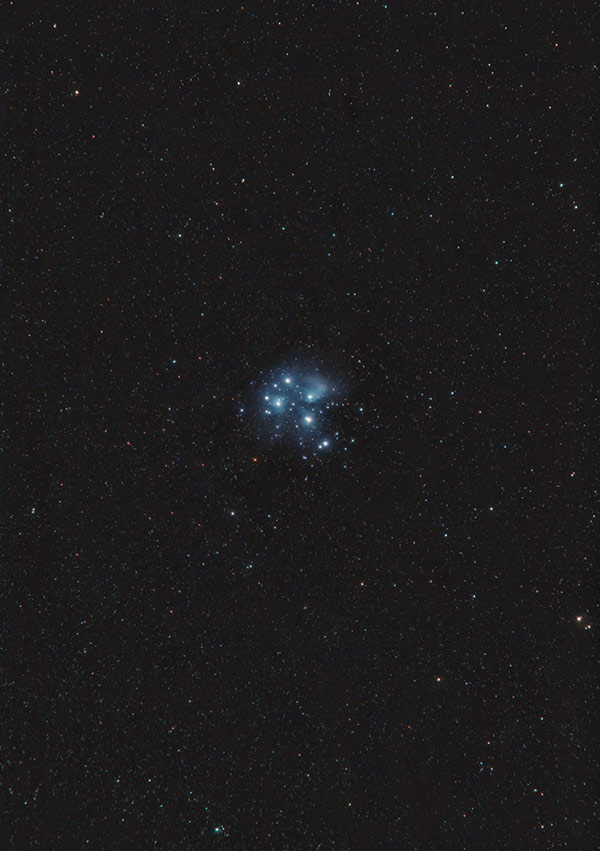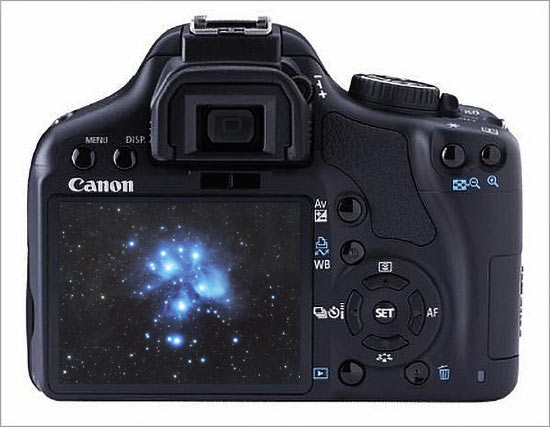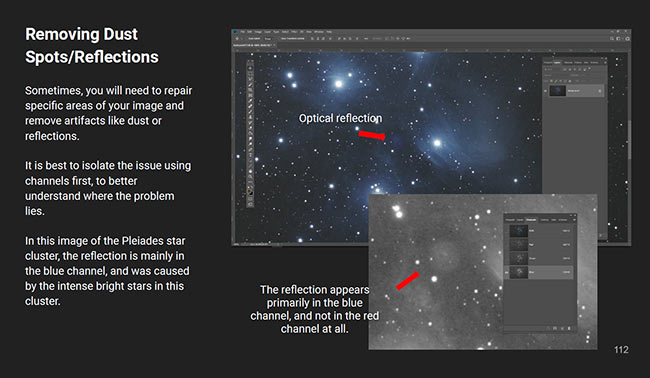The Pleiades Star Cluster
The Pleiades is an open star cluster in the constellation Taurus. It lies about 400 light-years from Earth and is about 100 million years old.
In the northern hemisphere, the fall and winter seasons are the best times to observe and photograph the Pleiades.
Although the cluster consists of over 1000 stars, the “Seven Sisters” dominate your visual and photographic attention. Some people see more than 7 stars, while others see less.
The Pleiades are visible from most parts of the globe and appear as a “misty dipper of stars” in Taurus. To find the Pleiades, use the bright orange star Aldebaran as a guide.
If you draw an invisible line from Orion’s Belt to Aldebaran, you’ll eventually reach the Pleiades.
Above: My latest image of the Pleiades Star Cluster was captured from a dark sky site using a one-shot-color dedicated astronomy camera (ZWO ASI2400MC Pro) and a compact Apochromatic Refractor Telescope (William Optics RedCat 71). This image includes just over 4 hours of total exposure time.
The Pleiades
The Pleiades star cluster is one of the nearest star clusters to Earth and the most obvious naked-eye cluster in the night sky.
It is both a star cluster and an asterism (a small one) because it is a pattern of stars that is not a constellation.
The cluster contains middle-aged, hot B-type stars, which are very luminous and blue.
With the unaided eye, most people count 6 stars in the Pleiades star cluster, not 7. With a pair of binoculars or a telescope, you will see many more stars in the cluster.
- Common Name: The Pleiades
- Object Type: Open cluster
- Cataloged: Messier 45 (M45)
- Other Names: Seven Sisters, Subaru
- Constellation: Taurus
- RA (right ascension): 03h 47m 24s
- DEC (declination): +24° 07′ 00″
- Age: About 100 million years
- Distance: 444.2 light-years
- Apparent Magnitude: 1.6
- Angular Size: 110 arcmins
The Pleiades Star Cluster captured using a DSLR and telescope
What is So Special About the Pleiades?
This cluster of stars is instantly recognizable in the night sky and has a way of captivating those who view them.
The bright blue stars of the Pleiades are thought to be hundreds of times more luminous than our sun.
In Greek mythology, the Pleiades were the seven sister-nymphs, companions of Artemis, the goddess of the hunt.
With their sisters, the Hyades (the Hyades Star Cluster), they were called the Atlantides.
Subaru (the Japanese version for the word, “unite”), represents the Pleiades and is even featured on the automotive brands logo.
An Open Star Cluster
The Pleiades is classified as an open star cluster. This means that the stars were formed from the same molecular cloud and are roughly the same age.
There are more than 1000 open clusters within the Milky Way Galaxy.
The Pleiades star cluster also contains striking blue reflection nebulae, which were once thought to be leftover material from their formation.
Later studies have shown that these are unrelated dust clouds in the interstellar medium.
The dusty cosmic cloud surrounding the Pleiades, and the associated blue reflection nebula can be enjoyed through long-exposure astrophotography.
What Does it Look Like?
To capture an image that highlights the faint, glowing dust that surrounds the Seven Sisters star cluster, dark skies that are well away from city light pollution are required.
This APOD image shows just how dusty the area surrounding M45 is. Photographs will show much more detail on this object than you can see with your naked eye.
Below, is a wide-field view of the Pleiades using a 105mm camera lens. This image is a good representation of what it’s like to observe M45 from a dark sky site through a small telescope.
The Pleiades at 105mm using a DSLR and 24-105 Camera Lens
The image above showcases the Pleiades in a 7-degree wide field of view. At this magnification, at least 7 stars are obvious in the cluster and are typically what you’ll see from a dark sky location.
The Seven Sister stars of the Pleiades are Maia, Electra, Alcyone, Taygeta, Asterope, Celaeno, and Merope.
November is often called the month of the Pleiades. At this time of year, the Pleiades shine from dusk until dawn.
In the image below, you’ll see the proximity of the Pleiades to the constellation Orion.
The Pleiades star cluster can be seen to the right of the constellation Orion.
For many people, this star cluster is one of the first deep-sky objects ever observed with their naked eye.
There are very few deep-sky objects that are as bright (apparent magnitude +1.6) and noticeable as the Pleiades.
Binoculars are a great tool for observing the Pleiades, as this star cluster covers a relatively large area of sky (apparent dimensions 110′ arcmin.).
A wide field of view from a pair of binoculars or a low-power telescope will ensure that the entire cluster can be seen at the same time.
Few star clusters can deliver the excitement and awe that Messier 45 does through the eyepiece of a telescope.
For a truly remarkable way to enjoy this object, consider attaching a camera to your telescope.
How Old is the Pleiades Star Cluster?
The Pleiades star cluster is relatively young, as far as star clusters go. Astronomers estimate the age of the Pleiades to be around 100 million years old.
Interestingly, this means that the Pleiades were born after the Jurassic period when dinosaurs roamed the Earth.
Astronomers can estimate the age of the Pleiades Star Cluster by applying by determining the highest mass of brown dwarfs still containing lithium in the cluster.
Using this method, astronomers estimate a more precise age of 115 million years.
Astrophotography
A photograph of the Pleiades star cluster looks great at any focal length, from a wide-angle nightscape to a high-magnification deep-sky image.
Whether you are using a camera lens, or a telescope, to effectively capture the faint, dusty details of the associated reflection nebula, a star tracker must be used to allow for long exposure imaging.
Because the night sky appears to be moving from our vantage point on Earth, a tracking mount is needed to “freeze” the object in place.
A simple astrophotography setup will include a tracking camera mount and a DSLR camera with a telephoto lens attached.
For a deeper look into this object, an equatorial telescope mount will help to collect high-magnification images using focal lengths of 500mm or more.
The astrophotography setup shown below is a good example of the type of equipment needed for a shot like this.
A refractor telescope attached to an EQ mount for astrophotography.
The telescope is an Explore Scientific ED80, and the mount is a Celestron CG-5 (Now the Celestron AVX).
Apochromatic refractors are an excellent choice for astrophotography, especially for those transitioning from a camera lens to a telescope.
For this target, the biggest advantage you can give yourself is to shoot under dark skies away from city light pollution.
Reflection nebulae are broadband color targets, that do not benefit from narrowband filters to isolate specific gases.
Recommended Article: The Best Astrophotography Telescopes Available in 2023
Image Through a Telescope
By stacking multiple exposures together in software called DeepSkyStacker, I was able to increase the signal-to-noise ratio of the image.
This makes image processing much easier, as the camera noise is reduced, and the fine details from the nebula can be gently pulled forward.
Photo Details
- Camera: Canon EOS Rebel Xsi (stock)
- Telescope: Explore Scientific ED80 Triplet APO refractor
- Mount: Celestron Advanced Series CG-5
- Total Exposure: 1 Hour, 27 Minutes
- Sub Exposures: 25 x 3.5-minutes
- White Balance: Auto
- ISO: 1600
- Calibration Frames: 16 Dark Frames, 16 Flat Frames, 16 Bias Frames
- Stacking and Calibration: DeepSkyStacker
- Final Processing: Adobe Photoshop CC
The Explore Scientific ED80 is a triplet apochromatic refractor telescope with an 80mm ED objective lens. With a focal length of 480mm and an f-ratio of F/6, this refractor is truly versatile for medium-to-large deep sky objects such as M45.
This telescope is compact, easy to transport, and includes features that are important for astrophotography like a 10-1 speed focuser with adjustable tension and lock. This was my first “true” astrophotography telescope, and it helped me get over the steep learning curve involved with deep sky astrophotography early on.
Camera Settings and Tips
For this target, any camera capable of astrophotography will do. A stock DSLR camera (such as the Canon EOS Rebel XSi) is capable of producing incredible images of this cluster.
Reflection nebulae, in general, do not require a modified DSLR camera to record effectively.
The additional wavelengths of light captured with a full-spectrum modified camera are most beneficial for capturing Ha (Hydrogen-alpha), not the glowing blue light of the reflection nebulosity found in the Pleiades.
You’ll want to use manual mode on your camera and set the camera dial to bulb mode to collect ultra-long exposures of at least 2 minutes each or more.
Longer exposures will begin to reveal the faint outer nebulosity and dust surrounding the star cluster.
By shooting your image in RAW format, the white balance setting you choose is irrelevant, as you can change this later in post-processing.
However, I usually leave the white balance set to auto or daylight for all of my astrophotography images as a starting point.
To focus the star cluster using a DSLR in both a camera lens and/or telescope, I recommend using the live-view feature on your camera.
You can then zoom in to 10X to make fine adjustments to the focus until the bright stars are as sharp as possible.
Here are some more astrophotography tips that apply to a wide variety of imaging scenarios:
- Use a “fast” aperture of F/2.8 – F/4
- Set your white balance setting to daylight
- Use manual mode
- Set exposure length at 30 seconds
- Shoot in RAW image format
- Use an ISO of 400-1600 (or more)
Using a Light Pollution Filter
For the absolute best results, try to photograph the Pleiades star cluster from a dark sky location, during the new moon phase, without the use of any filters.
This will allow all of the natural starlight to be collected and have the best potential for a beautiful shot.
If you want to capture this target from your backyard in the city, a light pollution filter can help to isolate deep sky objects from a washed-out city sky.
As an example, have a look at the unprocessed single frame vs. a color-balanced version.
The image comparison below was captured using a DSLR and camera lens from my Bortle Class 8 backyard in the heart of the city.
The lens used was a Canon EF 24-105mm F4/L at its maximum focal length of 105mm.
An unprocessed single frame of the Pleiades from the city vs. stacked and corrected version
Overall Exposure Time
There is a massive amount of dust within the Pleiades star cluster and can be captured in detail with enough exposure time.
This 12-hour exposure displays just how much dust there really is surrounding the Pleiades star cluster.
One of the benefits of shooting Pleiades with a DSLR camera is the ability to focus using the bright stars of M45.
Unlike many faint nebulae and globular clusters in the night sky, Pleiades is easy to find and shows up well on your camera’s live view screen.
The majority of the deep sky objects I photograph are far too dim to identify through a camera lens with my DSLR.
Thankfully, Pleiades is an exception to this, which is why it is such a popular deep-sky target for beginners.
My first image of the Pleiades from 2011
Using a Full Frame DSLR Camera
A full-frame DSLR camera and a wide-field telescope is a great combination to use when photographing this star cluster.
The image below was captured using a stock Canon 5D Mk II and a William Optics Zenithstar 73.
An Optolong L-Pro broadband filter helped to reduce city glow without creating any harsh color casts.
It’s worth mentioning that this shot was captured from a red zone, with a 60% illuminated moon nearby:
Image Processing
The challenge when processing Messier 45 is the extremely bright and large stars in the image. These stars may have caused some odd reflections in your image, which will be removed using either the clone tool or the healing brush.
The content-aware fill feature in Adobe Photoshop will also handle the task quite well.
The image processing steps needed for an image of a star cluster are quite different than they are for a galaxy or nebula. Because the focus is on the stars themselves, less stretching (curves, levels) of the data is needed.
Learn the process of removing reflections in your astrophotos in my complete image processing guide.
For most of my deep-sky images, my goal is to tame the bright stars and pull the light from the DSO (deep-sky object) forward. The Pleiades is a challenge because the stars and reflection nebulae are featured together.
This is why you will see so many variations of M45 with fluctuating amounts of nebulosity.
M45 is a tremendous deep sky astrophotography target, no matter what photography equipment you’re using. I hope that my experiences photographing the Pleiades over the years have inspired you to take your own shot.













